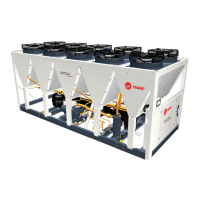CG-SVX039C-GB
65
Free-Cooling Enabling Conditions:
To get the free-cooling active, condition is to have unit in
active cooling mode and that Outdoor temperature low
enough according to figure below.
The free-cooling function is enabled when outdoor air
temperature is below Active chilled water cooling set
point minus FC offset.
A hysteresis should also apply to avoid short cycling of
Free-cooling enabling logic. The Free-cooling offset is an
adjustable parameter to make free-cooling active.
If free-cooling function is enabled, free-cooling becomes
the 1st stage of cooling. Free-cooling is the first stage to
engage for cooling capacity loading and the last stage to
consider in capacity unloading.
Figure 22 – Free-cooling enabling conditions
1 deg.C
Free Cooling Active
Free Cooling Inactive
Free Cooling Target Offset
Chiller Entering Water Temperature
Free Cooling Activation Target
In Order to maximize tandem operation of free-cooling
with compressor the following logic is applied:
When unit is configured in “Partial free cooling”, when
free-cooling reached its full capacity and there is a
call for compressor start, the first circuit to start shall
be circuit2 (if available). This also means compressor
balancing function is disabled in these conditions.
Note: UC800 will not lockout compressor below free-
cooling change over point, but the compressor is locked
out when outdoor air is below “low ambient limit” set
at -10°C. So FC will be the only source of cooling below
-10°C.
Note for installation: All Submittal, lifting diagram,
neoprene pads positioning, and wiring diagrams have
been supplied with chiller order.
The maximum pressure for unit with Glycol free and
Direct free-cooling is 400kPa. Refer to unit nameplate for
rated value.
Pump Operating with Glycol Free: It is requested to
have a minimum water side pressure of 250kPa to avoid
cavitation.
Glycol free Option: To avoid component damage, a filter
(1mm mesh) must be supplied by the customer and
installed at the unit inlet.
Unit is shipped without glycol content on the free-
cooling circuit.
Free-cooling loop venting must be performed by using
manual overload mode to run the free-cooling pump and
opening free-cooling and closing bypass valve.
At 10 to 20°C ambient, the expansion shall be
pressurized at 250kPa. It should be checked when glycol
loop is not yet filled or glycol pressure is near zero.
All Free-cooling units must be freeze-protected with at
least 30% Ethylene Glycol and to minimum ambient
temperature in the cooling loop circuit in order to protect
the unit against freezing. Upon receipt, make sure that
there is no remaining test water in the free-cooling
circuit as it may freeze during winter periods.
Water can be trapped in BPHE and specific care must
be taken to remove it completely from BPHE during off
mode if drainage is the winter protection chosen.
The free-cooling option circuit consists of copper,
carbon steel, cast iron, zinc, synthetic rubber, brass,
and Aluminium AA3102, AA3003, AA4045 in addition
to other materials that may be in the building loop
connected to the chiller. The inhibited glycol solution
should be selected at desired concentration to ensure
adequate inhibitor content. It is not advised to dilute a
stronger concentrate due to inhibitor dilution. Glycol
fluid should be free from foreign solid particles. A
maintenance schedule should be selected per the
glycol manufacturer’s requirements to insure adequate
protection during product usage.
Note: Equipment Damage! Failure to follow instructions
below could cause equipment damage.
DO NOT USE UNTREATED WATER. Glycol solution must
be utilized with Free-cooling option. Glycol percentage
should be based on freeze avoidance requirements.
The glycol solution requires an inhibitor package to
be carefully chosen with the aid of a qualified water
treatment specialist to abate corrosion in a mixed metal
system.
The building glycol loop should not be vented to
atmosphere. A closed system is required to limit
oxidation potential within the loop.
Make-up water should be avoided.
Figure 23 – Schematic – Free-cooling option
Direct Free-cooling
Optional Free-Cooling

